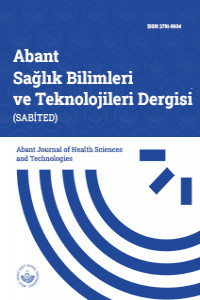Seda YAKIT YEŞİLYURT, Elif DUYGU YILDIZ, Büşra İNAL, Seda AYAZ TAŞ, Hatice ÇANKAYA, Merve BAŞOL GÖKSÜLÜK, Nuriye ÖZENGİN
ÜRİNER İNKONTİNANSLI KADINLARIN İNKONTİNANS VE PROLAPSUS BİLGİ DÜZEYİNİN İNCELENMESİ
Bu çalışmanın amacı üriner inkontinanslı kadınların inkontinans ve prolapsus bilgi düzeyini incelemekti. Çalışmaya yaş ortalaması 48.75±11.88 olan 96 üriner inkontinaslı kadın dahil edildi. Kadınların fiziksel ve sosyodemografik özellikleri, üriner inkontinans varlığı, inkontinans ve prolapsus bilgi düzeyleri sırasıyla değerlendirme formu, 3 İnkontinans Anketi, Prolapsus ve İnkontinans Bilgisi Anketi ölçekleri ile değerlendirildi. Kadınların bilgi düzeyleri değerlendirilirken bilgi yeterliliği için inkontinans alt ölçeğinden %80 ve üzeri, prolapsus alt ölçeğinden %50 ve üzeri puan almaları beklendi. Çalışma sonucunda üriner inkontinanslı kadınların inkontinans bilgi düzeyi %66,6 ile inkontinans alt ölçeği için belirlenen %80 eşiğinin altında bir değer olarak tespit edildi. Kadınların prolapsus bilgi düzeyi ise %58,3 ile prolapsus alt ölçeği için belirlenen %50 eşiğinin hemen üzerinde bir değer olarak belirlendi. Bu çalışma ile kadınların inkontinans bilgi düzeyinin yetersiz olduğu bulundu. Prolapsus bilgi düzeyinin ise genel populasyona göre yeterli olduğu belirlendi.
Anahtar Kelimeler:
Bilgi, Hasta eğitimi, Üriner inkontinans
___
- Haylen B, Ridder D de, Freeman R, et al. An International Urogynecological Association (IUGA)/International Continence Society (ICS) joint report on the terminology for female pelvic floor dysfunction. Int Urogynecol J,2010;21:5–26.
- Jiang K, Novi JM, Darnell S, Arya LA. Exercise and urinary incontinence in women. Obstet Gynecol Surv, 2004;59(10):717–21.
- Wood LN, Anger JT. Urinary incontinence in women. BMJ, 2014;349:g4531.
- Batmani S, Jalali R, Mohammadi M, Bokaee S. Prevalence and factors related to urinary incontinence in older adults women worldwide: A comprehensive systematic review and meta-analysis of observational studies. BMC Geriatr, 2021;21(1):212.
- Sharma JB, Thariani K, Kumari R, Kaur T, Uppal B, Pandey K, et al. Short and long term follow up and efficacy of trans obturator tape for management of stress urinary incontinence. J Obstet Gynecol India, 2021;71(3):285–91.
- Mostafaei H, Sadeghi-Bazargani H, Hajebrahimi S, et al. Prevalence of female urinary incontinence in the developing world: A systematic review and meta‐analysis—A report from the developing world committee of the. Neurourol Urodyn, 2020;39(4):1063–86.
- Basak T, Kok G, Guvenc G. Prevalence, risk factors and quality of life in Turkish women with urinary incontinence: A synthesis of the literature. Int Nurs Rev, 2013;60(4):448–60.
- Voorham-van Der Zalm PJ, Stiggelbout AM, et al. Development and validation of the Pelvic Floor Inventories Leiden (PelFIs). Neurourol Urodyn, 2008;27(4):301–5.
- Mandimika C, Murk W, McPencow A, et al. Knowledge of pelvic floor disorders in a population of communitydwelling women. Am J Obstet Gynecol, 2014;210(2):165.e1-165.e9.
- O’neill AT, Hockey J, O’brien P, et al. Knowledge of pelvic floor problems: a study of third trimester, primiparous women. Int Urogynecol J, 2017;28:125–9.
- Fante J, Silva T. Do women have adequate knowledge about pelvic floor dysfunctions? A systematic review. Rev Bras Ginecol Obs, 2019;41(8):508–19.
- Neels H, Wachter S De, Wyndaele J, Tjalma W, Wyndaele M, Vermandel A. Knowledge and believes about pelvic floor muscles and (dys) function: A cross sectional study in women of different age groups. Eur Urol, 2015;14(2):e356.
- Chiarelli P, Murphy B, Cockburn J. Women’s knowledge, practises, and intentions regarding correct pelvic floor exercises. Neurourol Urodyn, 2003;22(3):246–9.
- Paka C, Hallock J, Trock B, Steele K, Wright J. Urinary incontinence and pelvic organ prolapse knowledge, careseeking, and embarrassment in women planning bariatric surgery: A Cross-sectional. Female Pelvic Med Reconstr Surg, 2020;26(4):276–80.
- Neels H, WyNdaele J-J, TJalma W, de wacHTer St, WyNdaele M, VermaNdel A. Knowledge of the pelvic floor in nulliparous women. J Phys Ther Sci, 2016;28:1524–1533.
- Neels H, Tjalma WAA, Wyndaele J-J, De Wachter S, Wyndaele M, Vermandel A. Knowledge of the pelvic floor in menopausal women and in peripartum women. J Phys Ther Sci, 2016;28:3020–3029.
- Roe B, Wilson K, Doll H. Public awareness and health education: findings from an evaluation of health services for incontinence in England. Int J Nurs Stud, 2001;38(1):19–89.
- Brown JS, Bradley CS, Subak LL, et al. The sensitivity and specificity of a simple test to distinguish between urge and stress urinary incontinence. Ann Intern Med, 2006;144(10):715–23.
- Shah AD, Massagli MP, Kohli N, Rajan SS, Braaten KP, Hoyte L. A reliable, valid instrument to assess patient knowledge about urinary incontinence and pelvic organ prolapse. Int Urogynecol J, 2008;19(9):1283–9.
- Toprak Celenay S, Coban O, Sahbaz Pirincci C, et al. Turkish translation of the Prolapse and Incontinence Knowledge Questionnaire: validity and reliability. Int Urogynecol J, 2019;30(12):2183–90.
- Shah AD, Shott S, Kohli N, Wu JM, Catlin S, Hoyte L. Do racial differences in knowledge about urogynecologic issues exist? Int Urogynecol J, 2008;19:1371–8.
- Chiung C, Chen G, Cox JT, Yuan C, Thomaier L, Dutta S. Knowledge of pelvic floor disorders in women seeking primary care: a cross-sectional study. BMC Fam Pract, 2019;20:70.
- Vasconcelos CTM, Firmiano MLV, Oriá MOB, Vasconcelos Neto JA, Saboia DM, Bezerra LRPS. Women’s knowledge, attitude and practice related to urinary incontinence: systematic review. Int Urogynecol J, 2019;30(2):171–80.
- Kang Y. Knowledge and attitudes about urinary incontinence among community-dwelling Korean American women. J Wound Ostomy Cont Nurs, 2009;36(2):194–9.
- Maria Brito Cardoso A, de Paiva Lima CRO, Souto Ferreira CW. Prevalence of urinary incontinence in highimpact sports athletes and their association with knowledge, attitude and practice about this dysfunction. Eur J Sport Sci, 2018;18(10):1405–12.
- Dunivan G, Komesu Y, Cichowski S, Lowery C, Anger JT, Rogers RG. Elder American Indian women’s knowledge of pelvic floor disorders and barriers to seeking care. Female Pelvic Med Reconstr Surg, 2015;21(1):34–8.
- Başlangıç: 2021
- Yayıncı: Bolu Abant İzzet Baysal Üniversitesi
Sayıdaki Diğer Makaleler
RUHSAL BOZUKLUKLARDA SUÇA YÖNELİM: DERLEME
HEMŞİRELİK ÖĞRENCİLERİNİN KÜLTÜRLERARASI DUYARLILIK DÜZEYLERİ VE KARŞILAŞTIKLARI BAŞLICA SORUNLAR
Ümmühan YİĞİT, Simge ÇOŞKUN, Hacer ALPTEKER
COVİD-19 SÜRECİNDE HEMŞİRELİK ÖĞRENCİLERİNİN MERHAMET DÜZEYLERİNİN BELİRLENMESİ
ÜRİNER İNKONTİNANSLI KADINLARIN İNKONTİNANS VE PROLAPSUS BİLGİ DÜZEYİNİN İNCELENMESİ
Seda YAKIT YEŞİLYURT, Elif DUYGU YILDIZ, Büşra İNAL, Seda AYAZ TAŞ, Hatice ÇANKAYA, Merve BAŞOL GÖKSÜLÜK, Nuriye ÖZENGİN
YAŞLILIK DÖNEMİNDE GÖRÜLEN DEĞİŞİKLİKLER, FİZİKSEL İNAKTİVİTE, KİNEZYOFOBİ VE DÜŞMELER
